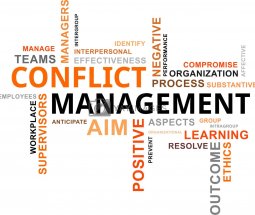Conflict Management
Conflict is natural in any organisation, including at the Committee table where diverse passions come together. Disagreements can relate to substantive issues such as the goals or the allocation of resources or can arise at an individual level in the form of disputes or complaints. The handling and recording of the issues and resolution steps is very important.
Regardless of the nature or the magnitude of the conflict, it is better to address it as soon as possible before it escalates. If it can't be resolved using the steps below, you may need external support.
Disagreement Resolution for Committee Members
It is worthwhile from time to time reminding Committee members that disagreement is healthy provided it doesn't involve personal attacks or is not too emotionally charged. The Chair needs to be diligent in directing members’ attention to issues and not people. It is also important that the Chair ensures that those who make the most noise don’t dominate discussion.
Disagreement, if entered into with an open-mind where members listen to each other can:
- Promote discussion around different view points and present alternatives
- Enhance awareness around the perceptions of others
- Assist in identifying issues that could arise
- Initiate change
When a major disagreement occurs in a Committee meeting it is helpful for the Committee to have an agreed protocol. Below is an example of steps that can be taken. Note if the Chair has strong opinions on the matter and is unable to lead discussions impartially, a replacement Chair for the meeting is needed.
Sample Committee Protocol
1. Decipher whether Committee Members are well enough informed around the issue. If not, defer the discussion to get more information, and be clear as to what information is needed
2. When discussing the issue, ask that the members be clear on 3 things:
- What is / are the real issues here – define what you are dealing with, even write it up on a whiteboard
- Have the group decipher if there are any aspects that they agree on
- Decide how and by when you propose to reach a resolution, the plan of attack
3. Remind members of the ground rules for discussion, e.g. listening to others, not interrupting others, not to repeat points over and over, no raising of voices…
4. Open for discussion with an intermittent summary statement from the Chair to clarify main point from each side, including any suggestions for resolution
5. Put up a Motion
6. Vote on the motion
7. Declare the decision and call for solidarity. The decision is ours “the Committee has decided”
Some empathy is required to those who have lost the argument and a reminder on how everyone is now expected to behave around the issue to gain wider spread support.
Member Disputes and Complaints
On receiving notice of a dispute or complaint the Committee should work through a consistent and transparent process of mediation or resolution.
In the case of disputes between members or between a member and the organisation, the Committee should firstly refer to their constitutional rules. Where a club has adopted the Model Rules for Incorporated Bodies, the mediation process is clearly spelt out. This can act as a guide for organisations where the Model Rules have not been adopted.
With regards to receiving notice of a complaint, the Committee should also have a clear and documented procedure for handling this. Complaints are inevitable, it is the way in which they are handled that will often determine whether a grievance escalates or is resolved.
Helpful Resources:
- Sample Grievance / Complaints Policy and Procedures
- Sample Grievance / Complaints Recording Sheet
- Sample Grievance / Complaints Register





